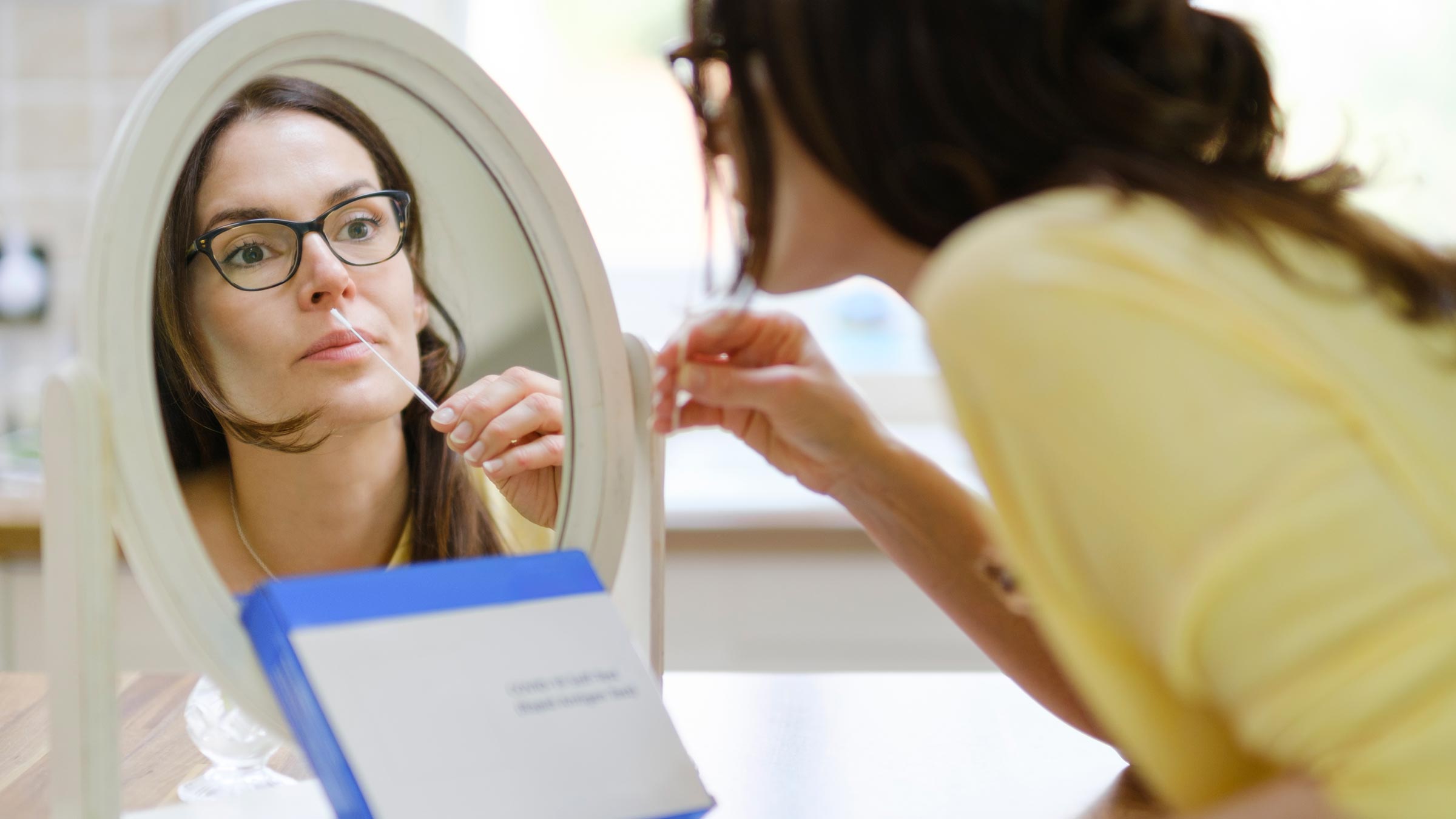
Editor’s note: As what we know about COVID-19 evolves, so could the information in this story. Find our most recent COVID-19 articles here and learn the latest in COVID-19 prevention at the Centers for Disease Control and Prevention. Some photos and videos on this site were filmed prior to the COVID-19 outbreak or may not reflect current physical distancing and/or masking guidelines.
At-home COVID-19 rapid test kits are valuable tools to help determine the likelihood of spreading COVID-19 to others. They offer quick and fairly accurate results — if you use them correctly. Here, we answer some common questions about the quality of at-home tests, how to use them and what to do with the results.
How do rapid tests compare to lab or doctor’s office tests?
Although there are many COVID-19 tests available, they can generally be broken into two types: molecular and antigen tests.
Molecular tests include nucleic acid amplification tests (NAAT) such as polymerase chain reaction tests (RT-PCR or PCR tests). They’re usually processed in a laboratory and are generally more accurate than antigen tests, but results can take longer.
At-home rapid tests are antigen tests, which use a different mechanism to detect infection. These tests can be processed in your home using a kit that looks similar to an at-home pregnancy test and gives results within 10-15 minutes.
Antigen tests are still fairly accurate, particularly when someone is experiencing symptoms and their viral load is very high. However, they can be less accurate when someone has a lower viral load, such as in someone without symptoms or someone very early in the course of their infection. This could lead to false negative test results. You could have a false negative result if, for example, you test yourself too soon after you’ve been exposed to someone with COVID-19, or if you test when you have no symptoms.
When should I use a rapid test, and when should I seek a lab or health care facility test?
The key difference between rapid antigen tests and PCR tests is that rapid tests aren’t always sensitive enough to tell you definitively if you have COVID-19 — what they’re better able to tell you is about your infectiousness and likelihood of transmission to others.
False positives with rapid tests are very unlikely; if you receive a positive result, you very likely have COVID-19. If you receive a negative result on your COVID-19 rapid test, there is still a possibility that you’ve been infected, but a negative result suggests that your viral load might not be high enough at that specific time for the test to detect the virus and therefore are less likely to transmit to others. This is why you should test yourself the day of gathering with others, to ensure that you have the most recent, most accurate reflection of infectious status.
Serial testing, meaning taking another test 1-2 days after the initial negative test, can be another strategy to improve accuracy (in case the initial test was done too early int he course of infection).
You should seek a molecular test such as a PCR from a facility that provides lab testing, such as The Ohio State University Wexner Medical Center, if…
- You’re experiencing symptoms of COVID-19 — even if you’re fully vaccinated (this includes people with symptoms consistent with COVID-19 who received a negative result on an at-home rapid antigen test).
- You don’t have symptoms of COVID-19, but you have known or suspected exposure to COVID-19. In this case, you should get tested and quarantine pending your test results. The CDC recommends testing at least 5 days after your last exposure. Check your local health department’s website for more information about testing options to possibly shorten this quarantine period.
- Your health care provider has recommended a test. After your test, stay in touch with your doctor regarding follow-up.
Is one at-home COVID-19 test better than another?
Each test maker is required to submit clinical data about the sensitivity (the ability of a test to detect a true positive) and the specificity (the ability of the test to detect a true negative) of the test. Because all at-home COVID-19 tests are allowed under an emergency use authorization from the U.S. Food and Drug Administration, the relative performance of individual tests hasn’t been as rigorously tested by the FDA — so it’s really difficult to say if one is “better” than another.
Are there any advantages to testing at home?
The major advantages are comfort and convenience — and the ability to get test results within 10-15 minutes.
Should you test at home for COVID-19 if you have no symptoms? What if you had close contact with a COVID-19-positive person or you have plans to gather with people outside your household?
You may consider doing COVID-19 testing ahead of time as another level of precaution before gatherings. If possible, taking an at-home rapid COVID-19 test the day of the event is ideal. While these tests aren’t 100% accurate, a negative result strongly suggests that you’re less likely to be contagious at that particular time.
It’s important to understand the limitations of the test — there’s a possibility for a false negative test, especially if you test too early after a possible exposure. The Centers for Disease Control and Prevention (CDC) recommends testing 5-7 days after your last exposure, if you’re fully vaccinated.
If you’re not fully vaccinated, the CDC recommends testing immediately after finding out you’ve had close contact with someone who has COVID-19. If results are negative, test again 5-7 days after last exposure — or immediately, if symptoms develop.
Serial testing — meaning repeating the test several days earlier before the actual gathering — can help improve accuracy of your results.
Some may choose to quarantine before an event, just as some did in 2020 prior to the COVID-19 vaccine rollout. Quarantining prior to an event probably isn’t necessary for everyone (especially for fully vaccinated individuals). The decision for family/friends to quarantine ahead of time is a personal decision based on individual risk tolerance.
How do I know I'm doing an at-home COVID-19 test properly?
It’s very important to follow the instructions from the manufacturer carefully. Read through the instructions and be sure you understand them prior to opening the test kit. Wash your hands and surfaces before starting the test.
If you don’t swab the nostrils properly, you may end up with a false negative test, so again, follow the instructions in the kit. You may feel uncomfortable swabbing this deeply into your nose or the nose of a loved one, but swabbing is fairly quick, and doing it correctly will improve the likelihood of an accurate test.
At-home rapid tests: Should we swab our throats, too?
What should you do if your at-home COVID-19 test is positive?
If your at-home test is positive, you should notify your health care provider and follow CDC guidelines for quarantine and isolation. It's also important to notify anyone you’ve been in close contact with so they can take the proper steps of testing and quarantining to help limit the spread of infection to others.
Does a negative home test mean you’re in the clear?
If you followed the instructions of the test carefully and you get a negative result, it’s unlikely that you have COVID-19 at that time. However, there are some circumstances where you may get a false negative result, particularly if you test too early in the course of the infection (when viral load is not as high). If you’re concerned about this, you could repeat the test a few days later.
How much do at-home tests cost? What if you can’t afford the cost?
COVID-19 rapid tests cost roughly $5 to $40. If you can't afford the cost of an at-home test, free COVID-19 testing is available at multiple locations. Some public libraries and local public health organizations have free COVID-19 rapid tests available for the public, although supplies tend to be limited.
As of Jan. 15, 2022, Americans can get reimbursements from their private health insurance for up to eight over-the-counter COVID-19 diagnostic tests per individual per month, starting Jan. 15, 2022. Insurers and group health plans are required to make these free by allowing consumers to get reimbursed by submitting a claim to their plan or by having their health plan pay for it upfront, says the U.S. Department of Health and Human Services.
Other useful tips:
- Get your flu shot. COVID-19 isn't the only contagious respiratory virus. There's also the flu. Yes, it's possible to contract both COVID-19 and the flu at once.
- Continue to wear a mask when you’re around others outside of your household. Those who haven't been fully vaccinated should wear well-fitting masks, and if weather permits, gather outdoors. Outside events are generally safer than indoor ones.
- If you’re sick, stay home. It’s not worth taking a chance to infect your co-workers, friends, classmates or loved ones if you’re unwell.

Our care, your place
Telehealth visits are a simple way to manage your health, wherever you are.
See what telehealth can do for you




